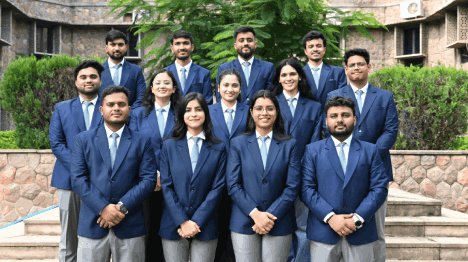- About Us
- Academics
Schools
Programs
General Information
- Faculty
The faculty members and researchers working at IIHMR University come from varied backgrounds including, but not limited to medicine, public health, management, economics, statistics, demography, human geography, social and behavioral sciences, rural development and pharmaceuticals.
- Admissions
- Research
.Publications & Journal
- Executive Education
Executive Programmes
- Online Certification Courses
ONLINE CERTIFICATION Courses
- Training
- Placements
- Fee Payment
- NAAC
- IQAC
- NIRF
- Webinars
- About Us
- About IIHMR University
- Board of Management
- Academic Council
- Board of Studies
- Research Board
- Institutional Review Board
- Finance & Audit Committee
- Departmental Research Committee
- Chairperson's Message
- President's Message
- IIHMR University Act
- Infrastructure
- Collaboration
- Ranking
- Board of Studies (School of Digital Health)
- Awards & Accolades
- Academics
- Institute of Health Management Research
- School of Pharmaceutical Management
- School of Development Studies
- School of Digital Health
- SD Gupta School of Public Health
- MBA (Hospital and Health Management)
- MBA (Pharmaceutical Management)
- MBA (Development Management)
- MBA (Healthcare Analytics)
- Master of Public Health
- Student Manual – Cohort 9 (2021-2023)
- Master of Public Health (Cooperative programme with Johns Hopkins University)
- Ph. D.
- MBA CSR & ESG Management (Executive)
- MBA Sustainable Business Management (Executive)
- Common Information for all the Programs
- Academic Calendar
- Student Handbook 2020-21
- Committees
- Policies
- Annual Exam Calendar
- Library
- Faculty
- Officers of University
- Dean of Institute of Health Management Research
- Dean of School of Pharmaceutical Management
- Dean of School of Development Studies
- Dean of SD Gupta School of Public Health
- Dean of School of Digital Health
- School of Digital Health
- Faculty List A to Z
- Faculty List Designation Wise
- Faculty List School Wise
- Admissions
- Research
- Executive Education
- Training
- Placements
- Alumni
- Events
- Job Openings
- Contact
- Research
Strengthening Convergent Action for Reducing Child under-nutrition
Agency : ICICI Foundation, Mumbai
The evaluation of the project “Strengthening Convergent Action for Reducing Child Undernutrition” was carried out in two blocks; namely, Kishanganj and Shahabad of Baran district in the state of Rajasthan. As per the Census 2011, out of the total 1.2 million population of Baran district, 21 percent are of tribal population, which predominantly belongs to Sahariya tribe. During the decade 2001-2011, the population growth rate in the district was 19.8 percent. Population sex ratio in Baran is 926 females per 1000 males, slightly less compared to the state’s sex ratio of 928. The literacy rate in the district is 67.38 percent closer to the state’s literacy rate of 66.11 percent. The total area of the district is 6955.40 square kilometer (sq. km) out of which only 35.88 sq. km is the urban part. The district has a population density of 175 inhabitants per sq. km, which is lower than the state’s population density of 450 inhabitants per sq. km. There are eight tehsils in the district, namely, Baran, Anta, Atru, Mangrol, Chhabra, Chhipabarod, Kishanganj, and Shahabad. The main dialect in the district is Hadoti. Out of the total population of the district, children below 6 years of age constitute 14.9 percent (Census 2011). The National Family Health Survey (NFHS) III data shows that children under 5 years of age, belonging to scheduled tribes in Rajasthan have the highest prevalence of severe acute malnutrition (SAM) 8.4 percent, which is higher as compared to scheduled castes (7.0 percent) and OBC (5.2 percent). A study conducted by NIN-ICMR in 2004 in this region has revealed that about 72 percent children of 1-5 years of age were underweight in Sahariya tribe. The proportion of severely underweight children in the same age group was about 24 percent.
The study reported that delayed complementary feeding of children was one of the major causes of retardation of growth among children. The study found that about two third of the children (68 percent) are put on complementary feeding between the ages of 13-18 months that adversely affects the proper growth of children. The ICDS program has been playing a critical role in providing nutrition services to the children through community-level Anganwadi Centers (AWCs). These AWCs aim to provide nutrition, health, and education services to children from their birth to six years of age. AWCs also provide nutrition and health services to pregnant, lactating mothers and adolescent girls. However, there are gaps between the stated aims of the program and its implementation, limiting the beneficial impact on children who are undernourished. It should also be noted that the utilization of each of the six ICDS services in Rajasthan is much lower than the national average. Thus, there is a need to improve efficient utilization of existing ICDS services, especially among the ruralcommunities to address the problem of undernutrition among children. Recognizing this need, the ICICI Foundation for Inclusive Growth entered a partnership with the Department of Women and Child Development (DWCD), Government of Rajasthan to launch a program to strengthen the delivery of health and nutritional services of ICDS in two blocks Kishanganj and Shahbad of Baran district through a three- pronged, comprehensive approach to prevention, management, and treatment of undernutrition.



